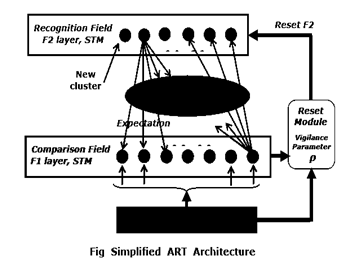SKEDSOFT
Introduction:-ART includes a wide variety of neural networks. ART networks follow both supervised and unsupervised algorithms. The unsupervised ARTs as ART1, ART2, ART3, are similar to many iterative clustering algorithms.
The simplest ART network is a vector classifier. It accepts as input a vector and classifies it into a category depending on the stored pattern it most closely resembles. Once a pattern is found, it is modified (trained) to resemble the input vector. If the input vector does not match any stored pattern within a certain tolerance, then a new category is created by storing a new pattern similar to the input vector. Consequently, no stored pattern is ever modified unless it matches the input vector within a certain tolerance.
This means that an ART network has
− Both plasticity and stability;
− New categories can be formed when the environment does not match any of the stored patterns, and
− The environment cannot change stored patterns unless they are sufficiently similar
General ART Architecture

There are two layers of neurons and a reset mechanism.
− F1 layer: an input processing field; also called comparison layer.
− F2 layer: the cluster units ; also called competitive layer.
− Reset mechanism: to control the degree of similarity of patterns placed on the same cluster; takes decision whether or not to allow cluster unit to learn.
There are two sets of connections, each with their own weights, called:
− Bottom-up weights from each unit of layer F1 to all units of layer F2.
− Top-down weights from each unit of layer F2 to all units of layer F1.